Fractional Active Disturbance Rejection Positioning and Docking Control of Remotely Operated Vehicles: Analysis and Experimental Validation
Abstract
:1. Introduction
- In order to better compensate for the non-matching disturbance caused by ocean currents on the kinematics of ROVs and to generate a smooth and ideal transition process, a double closed-loop control structure composed of a position control loop and a velocity control loop is adopted. In order to effectively enhance the robustness and dynamic performance of high-precision positioning and docking control of ROVs, a fractional-order controller is introduced in the velocity control loop. Its integral and differential orders can be arbitrarily selected, providing more flexibility than an integer-order controller. At the same time, the fractional-order controller exhibits strong robustness to changes in the parameters of the controlled object;
- The ROV nominal model is integrated into the extended state observer, and a model-assisted finite-time sliding-mode extended state observer is designed to eliminate the dependence on the accurate model. A Lyapunov function is formulated to demonstrate the finite-time convergence of the observation error. The introduction of this nominal model can effectively reduce the gain of the observer and improve the estimation accuracy. The sliding-mode technology can enhance the robustness of the observer, accelerate error convergence [27], and further improve the performance of the ROV positioning and docking control;
- Numerical simulations and pool experiments are conducted on the ROV to perform positioning and docking tasks in the presence of ocean current disturbances and model uncertainties. Compared to the currently most widely used PID and ADRC method, the control scheme proposed in this paper has advantages in high-precision operations.
2. ROV Modeling and Problem Formulation
2.1. ROV Kinematics
2.2. ROV Dynamics
2.3. Distribution of Thrust Forces
2.4. Control Objectives
3. Model-Assisted Finite-Time Sliding-Mode Extended State Observer
3.1. Design of MFSESO
3.2. Convergence Analysis of MFSESO
4. Double Closed-Loop Fractional-Order Controller
Design of DFOPID
5. Numerical Simulations and Pool Experiments
5.1. ROV Prototype
5.2. Numerical Simulations
5.3. Pool Experiments
6. Conclusions
Author Contributions
Funding
Data Availability Statement
Conflicts of Interest
References
- Makavita, C.D.; Jayasinghe, S.G.; Nguyen, H.D.; Ranmuthugala, D. Experimental Comparison of Two Composite MRAC Methods for UUV Operations with Low Adaptation Gains. IEEE J. Oceanic. Eng. 2020, 45, 227–246. [Google Scholar] [CrossRef]
- Uchihori, H.; Cavanini, L.; Tasaki, M.; Majecki, P.; Yashiro, Y.; Grimble, M.J.; Yamamoto, I.; van der Molen, G.M.; Morinaga, A.; Eguchi, K. Linear Parameter-Varying Model Predictive Control of AUV for Docking Scenarios. Appl. Sci. 2021, 11, 4368. [Google Scholar] [CrossRef]
- Ohrem, S.J.; Amundsen, H.B.; Caharija, W.; Holden, C. Robust adaptive backstepping DP control of ROVs. Control Eng. Pract. 2022, 127, 105282. [Google Scholar] [CrossRef]
- Xie, T.; Li, Y.; Jiang, Y.; Pang, S.; Xu, X. Three-dimensional mobile docking control method of an underactuated autonomous underwater vehicle. Ocean Eng. 2022, 265, 112634. [Google Scholar] [CrossRef]
- Wu, N.; Wang, M.; Ge, T.; Wu, C.; Yang, D.; Yang, R. Experiments on high-performance maneuvers control for a work-class 3000-m remote operated vehicle. Proc. Inst. Mech. Eng. Part I J. Syst. Control Eng. 2019, 233, 558–569. [Google Scholar] [CrossRef]
- Song, D.; Li, L.; Wang, C.; Hou, R.; Li, C. A practical robust yaw servo architecture of ROVs by multi-vector propulsion and nonlinear controller. Trans. Inst. Meas. Control 2020, 42, 2908–2918. [Google Scholar] [CrossRef]
- An, L.; Li, Y.; Cao, J.; Jiang, Y.; He, J.; Wu, H. Proximate time optimal for the heading control of underactuated autonomous underwater vehicle with input nonlinearities. Appl. Ocean Res. 2020, 95, 102002. [Google Scholar] [CrossRef]
- Zhang, T.; Miao, X.; Li, Y.; Jia, L.; Wei, Z.; Gong, Q.; Wen, T. AUV 3D docking control using deep reinforcement learning. Ocean Eng. 2023, 283, 115021. [Google Scholar] [CrossRef]
- Wang, T.; Sun, Z.; Ke, Y.; Li, C.; Hu, J. Two-Step Adaptive Control for Planar Type Docking of Autonomous Underwater Vehicle. Mathematics 2023, 11, 3467. [Google Scholar] [CrossRef]
- Li, S.; Zhang, X. The welding tracking technology of an underwater welding robot based on sliding mode active disturbance rejection control. Assem. Autom. 2022, 42, 891–900. [Google Scholar] [CrossRef]
- Han, J. From PID to Active Disturbance Rejection Control. IEEE Trans. Ind. Electron. 2009, 56, 900–906. [Google Scholar] [CrossRef]
- Gao, Z. Active disturbance rejection control: From an enduring idea to an emerging technology. In Proceedings of the 10th International Workshop on Robot Motion and Control, Poznan University of Technology, Poznan, Poland, 1 July 2015; IEEE: Poznan, Poland, 2015; pp. 269–282. [Google Scholar]
- Liu, C.; Xiang, X.; Yang, L.; Li, J.; Yang, S. A hierarchical disturbance rejection depth tracking control of underactuated AUV with experimental verification. Ocean Eng. 2022, 264, 112458. [Google Scholar] [CrossRef]
- Wang, C.; Cai, W.; Lu, J.; Ding, X.; Yang, J. Design, Modeling, Control, and Experiments for Multiple AUVs Formation. IEEE Trans. Autom. Sci. Eng. 2021, 19, 2776–2787. [Google Scholar] [CrossRef]
- Gao, J.; Liang, X.; Chen, Y.; Zhang, L.; Jia, S. Hierarchical image-based visual serving of underwater vehicle manipulator systems based on model predictive control and active disturbance rejection control. Ocean Eng. 2021, 229, 108814. [Google Scholar] [CrossRef]
- Zhou, Y.; Sun, X.; Sang, H.; Yu, P. Robust dynamic heading tracking control for wave gliders. Ocean Eng. 2022, 256, 111510. [Google Scholar] [CrossRef]
- Li, Z.; Liang, S.; Guo, M.; Zhang, H.; Wang, H.; Li, Z.; Li, H. ADRC-Based Underwater Navigation Control and Parameter Tuning of an Amphibious Multirotor Vehicle. IEEE J. Oceanic. Eng. 2024, 13, 4900. [Google Scholar] [CrossRef]
- Liu, C.; Xiang, X.; Duan, Y.; Yang, L.; Yang, S. ADRC-SMC-based disturbance rejection depth-tracking control of underactuated AUV. J. Field Robot. 2024, 41, 1103–1115. [Google Scholar] [CrossRef]
- Podlubny, I. Fractional-order systems and PID controllers. IEEE Trans. Autom. Control 1999, 44, 208–214. [Google Scholar] [CrossRef]
- Liu, L.; Zhang, L.; Pan, G.; Zhang, S. Robust yaw control of autonomous underwater vehicle based on fractional-order PID controller. Ocean Eng. 2022, 257, 111493. [Google Scholar] [CrossRef]
- Zhu, B.; Liu, L.; Zhang, L.; Liu, M.; Duanmu, Y.; Chen, Y.; Dang, P.; Li, J. A Variable-Order Fuzzy Logic Controller Design Method for an Unmanned Underwater Vehicle Based on NSGA-II. Fractal Fract. 2022, 6, 577. [Google Scholar] [CrossRef]
- Li, Q.; Yang, G.; Yu, F.; Chen, Y. Adaptive fractional order non-singular terminal sliding mode controller for underwater soft crawling robots with parameter uncertainties and unknown disturbances. Ocean Eng. 2023, 271, 113728. [Google Scholar] [CrossRef]
- Zhang, L.; Liu, L.; Zhang, S.; Cao, S. Saturation Based Nonlinear FOPD Motion Control Algorithm Design for Autonomous Underwater Vehicle. Appl. Sci. 2019, 9, 4958. [Google Scholar] [CrossRef]
- Cui, Z.; Liu, L.; Zhu, B.; Zhang, L.; Yu, Y.; Zhao, Z.; Li, S.; Liu, M. Spiral Dive Control of Underactuated AUV Based on a Single-Input Fractional-Order Fuzzy Logic Controller. Fractal Fract. 2022, 6, 519. [Google Scholar] [CrossRef]
- Liu, L.; Zhang, L.; Zhang, S. Robust PI controller design for AUV motion control withguaranteed frequency and time domain behaviour. IET Control Theory A 2021, 15, 784–792. [Google Scholar] [CrossRef]
- Hasan, M.W.; Abbas, N.H. An adaptive neural network with nonlinear FOPID design of underwater robotic vehicle in the presence of disturbances, uncertainty, and obstacles. Ocean Eng. 2023, 279, 114451. [Google Scholar] [CrossRef]
- Ali, N.; Tawiah, I.; Zhang, W. Finite-time extended state observer based nonsingular fast terminal sliding mode control of autonomous underwater vehicles. Ocean Eng. 2020, 218, 108179. [Google Scholar] [CrossRef]
- Abdurahman, B.; Savvaris, A.; Tsourdos, A. Switching LOS guidance with speed allocation and vertical course control for path-following of unmanned underwater vehicles under ocean current disturbances. Ocean Eng. 2019, 182, 412–426. [Google Scholar] [CrossRef]
- Hu, Q.; Jiang, B. Continuous Finite-Time Attitude Control for Rigid Spacecraft Based on Angular Velocity Observer. IEEE Trans. Aerosp. Electron. Syst. 2018, 54, 1082–1092. [Google Scholar] [CrossRef]
- Oustaloup, A.; Levron, F.; Mathieu, B.; Nanot, F.M. Frequency-band complex noninteger differentiator: Characterization and synthesis. IEEE Trans. Circuits Syst. I Fundam. Theory Appl. 2000, 47, 25–39. [Google Scholar] [CrossRef]
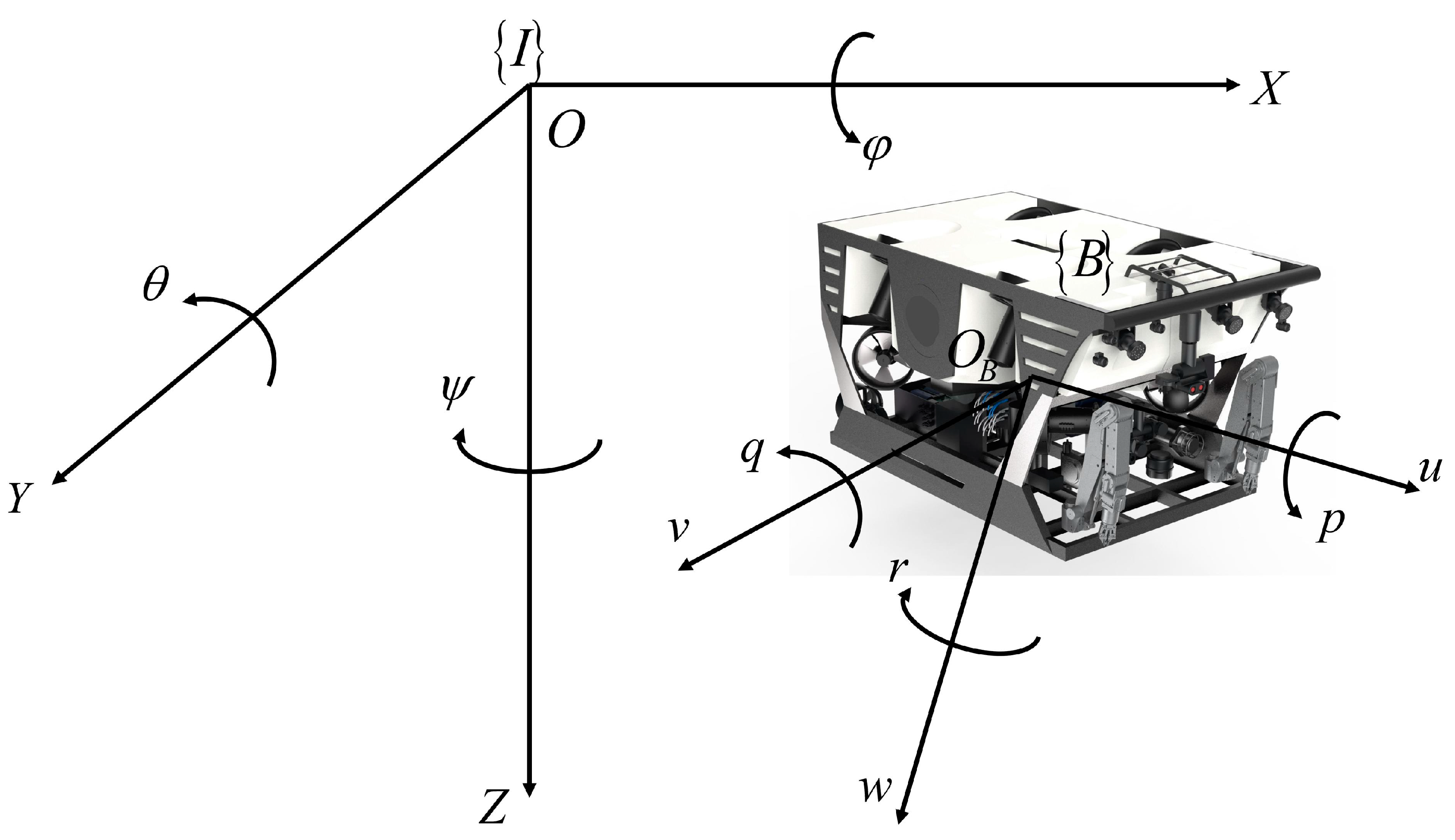
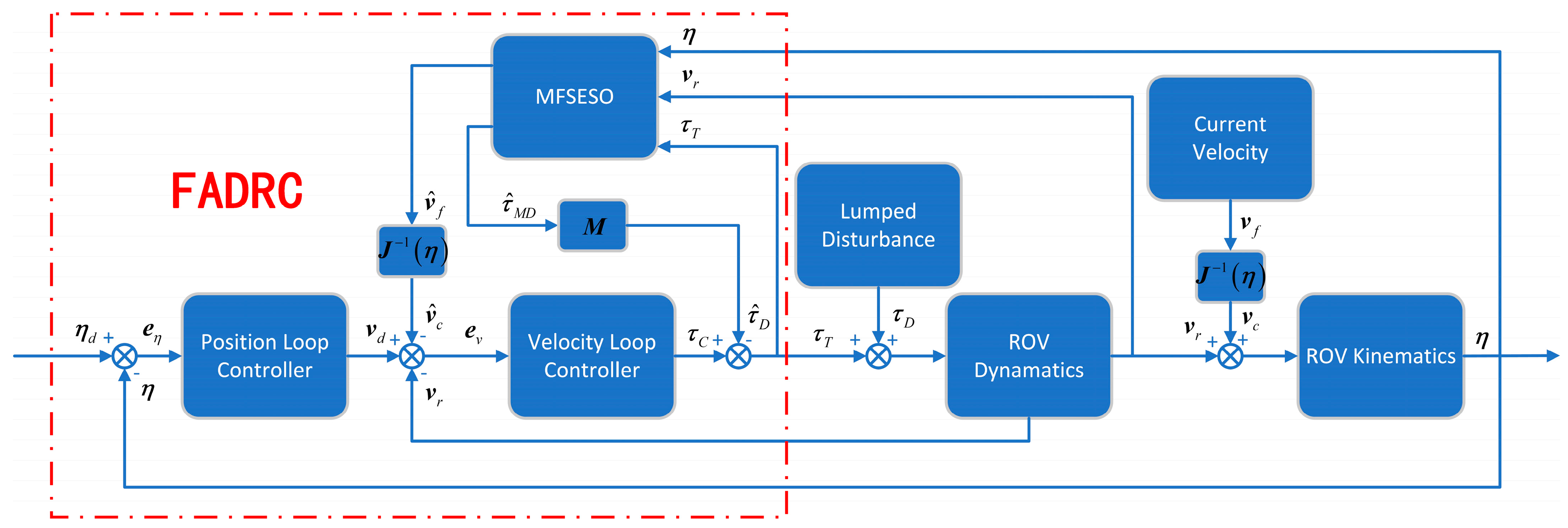


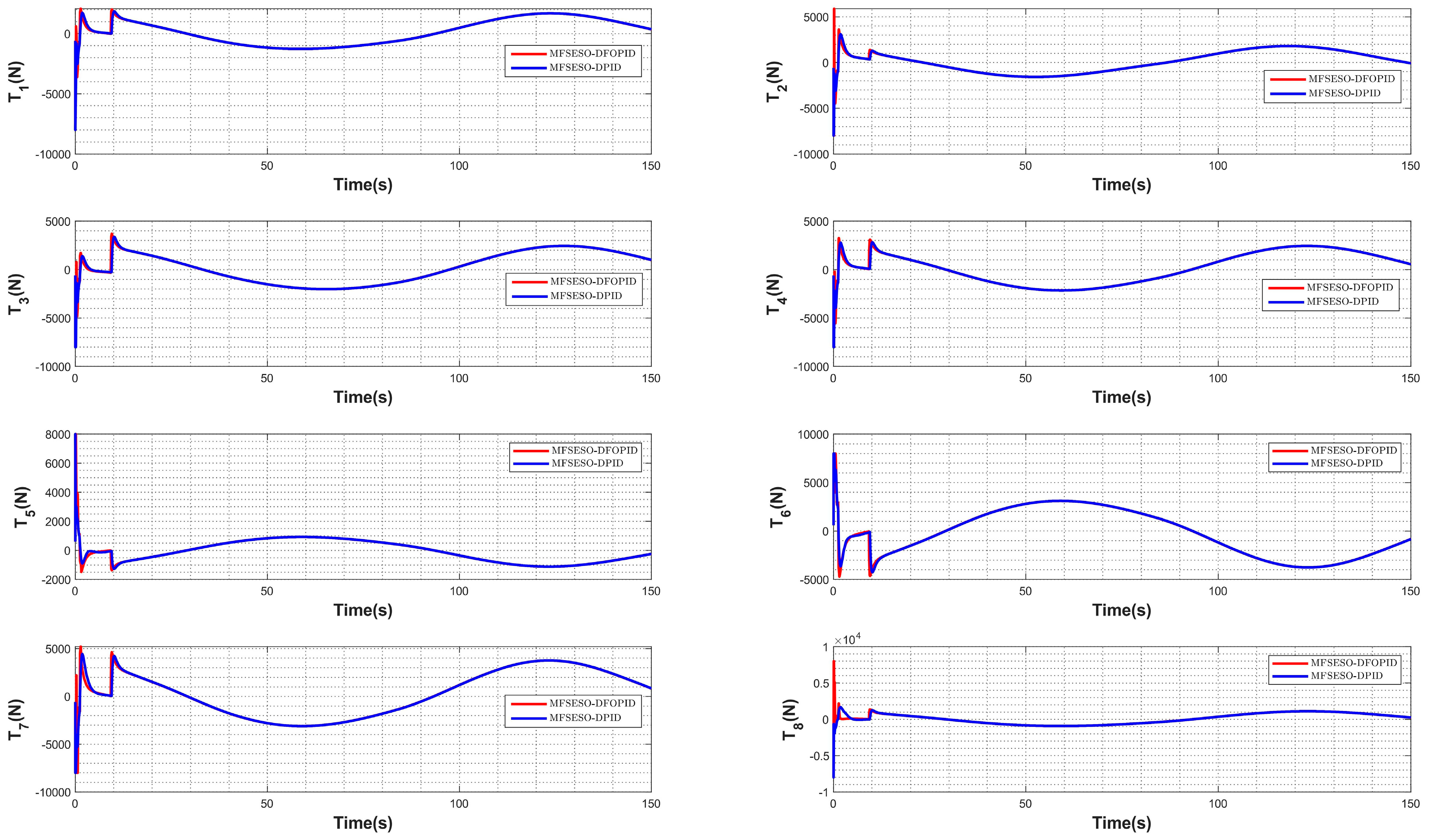

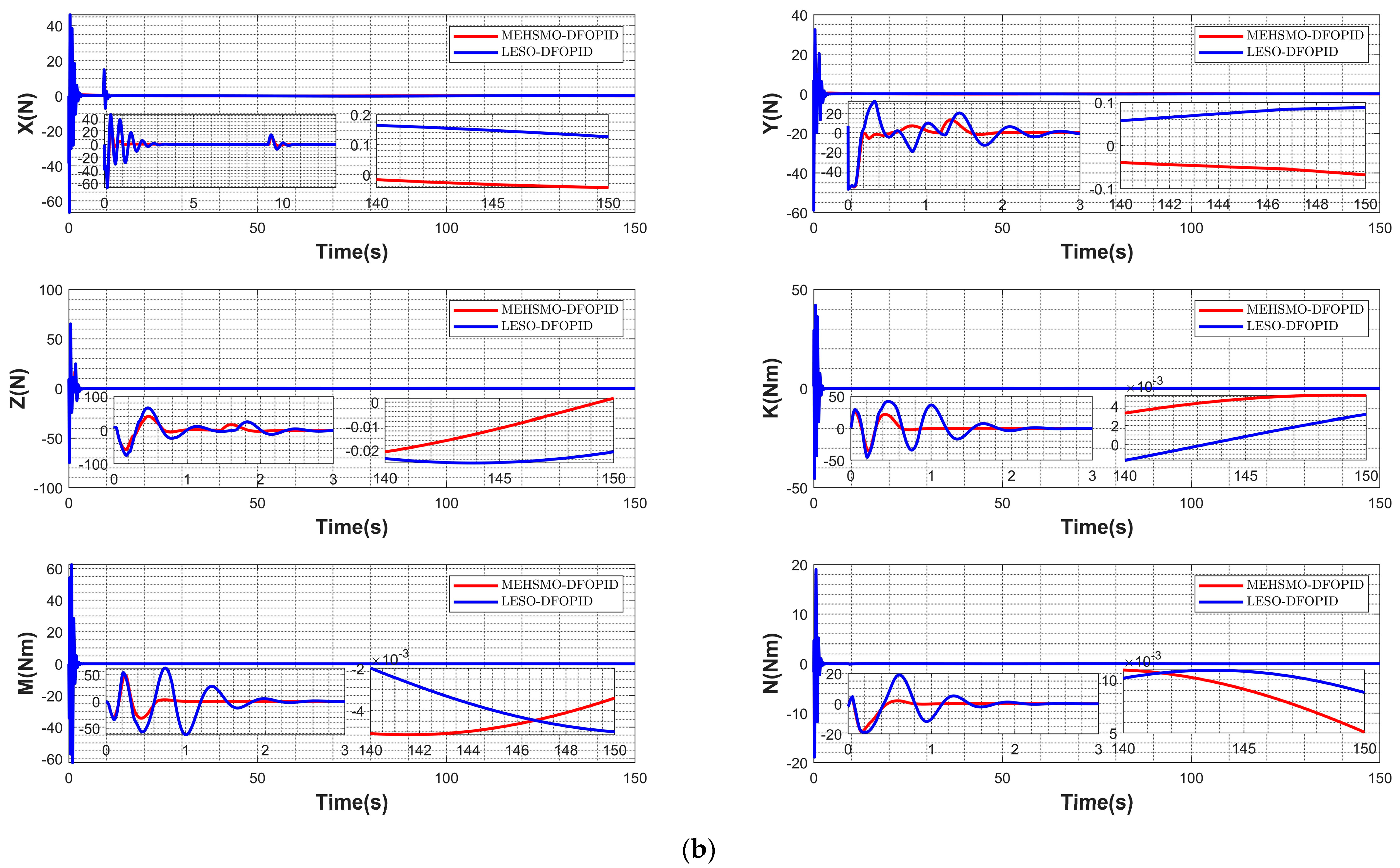
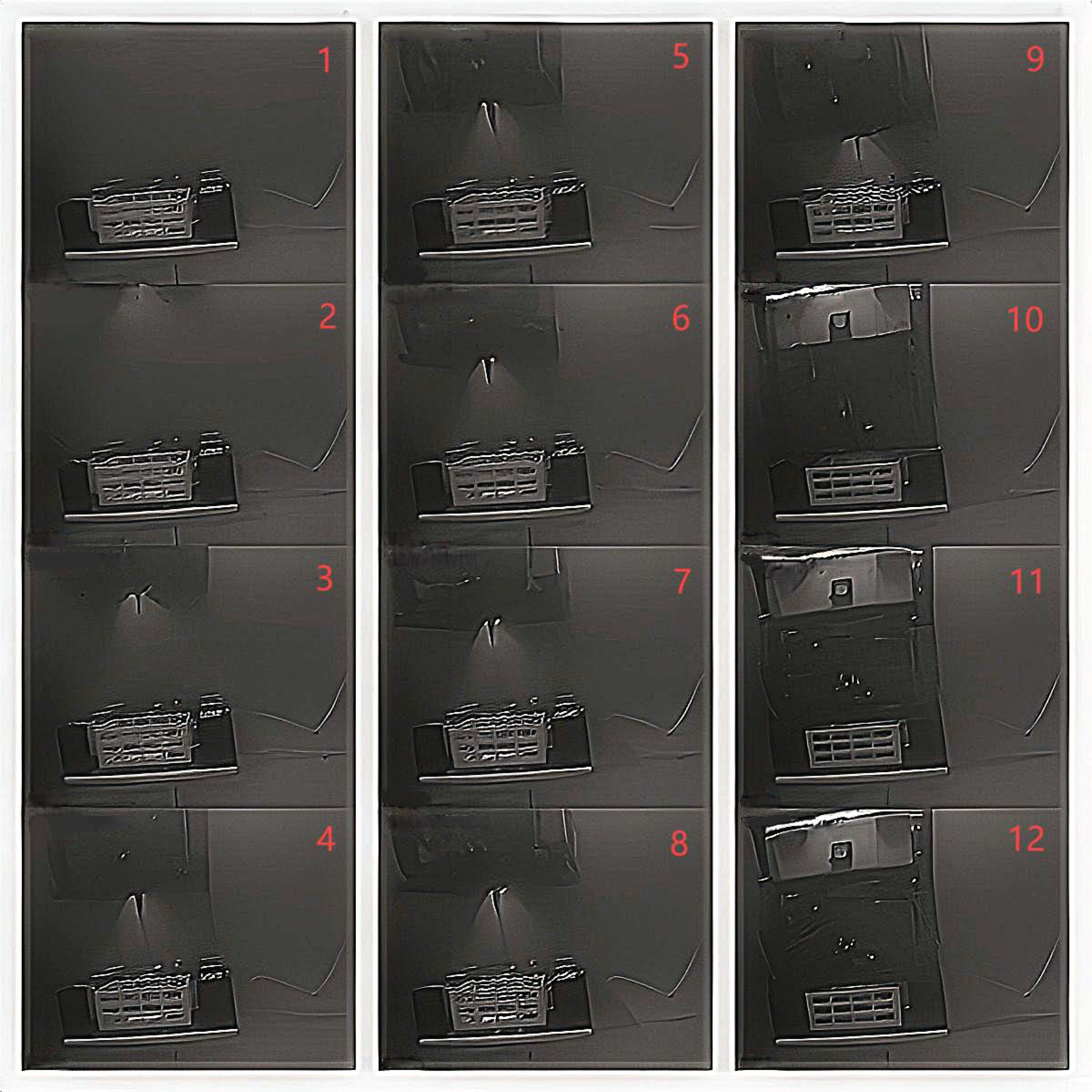
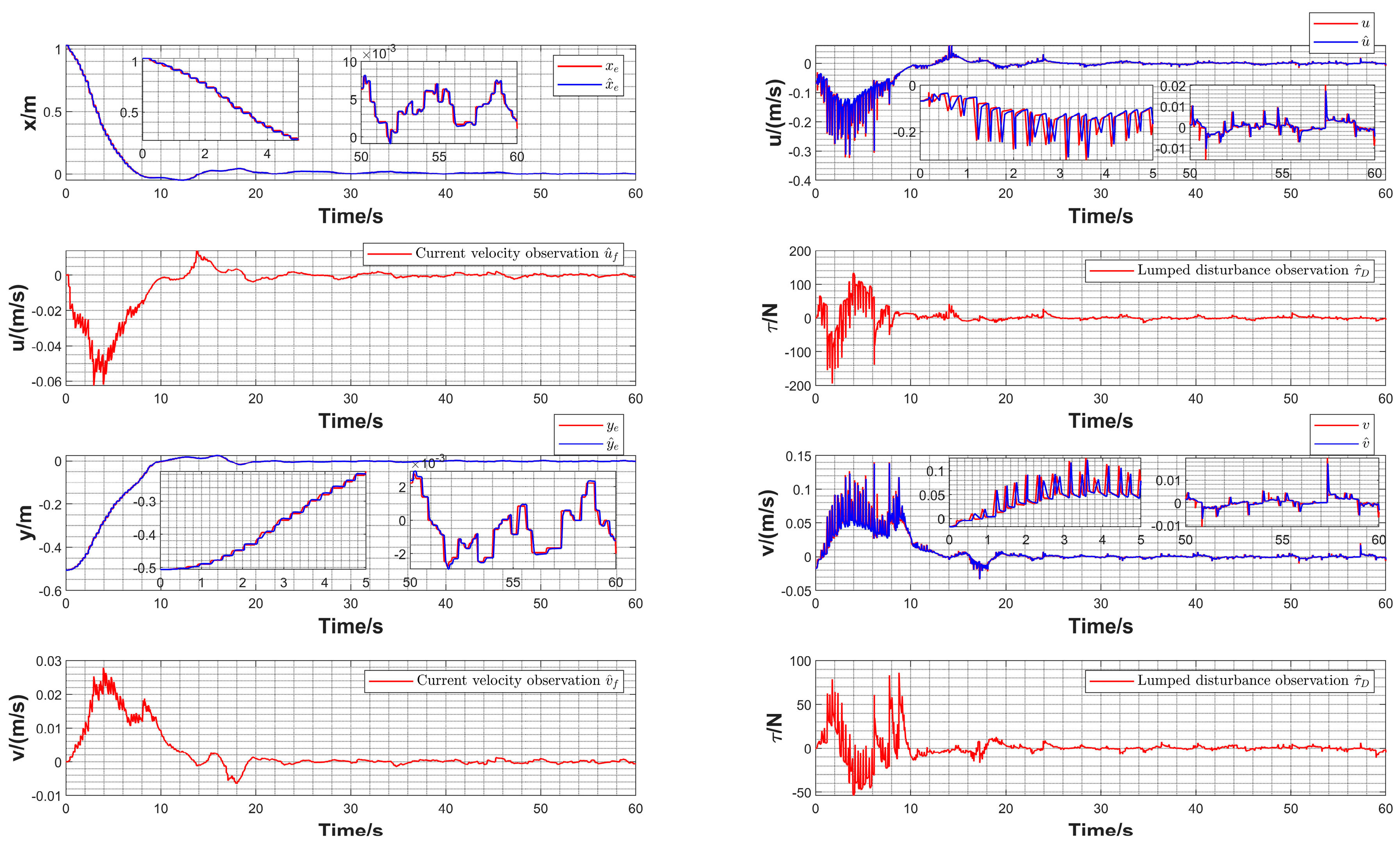
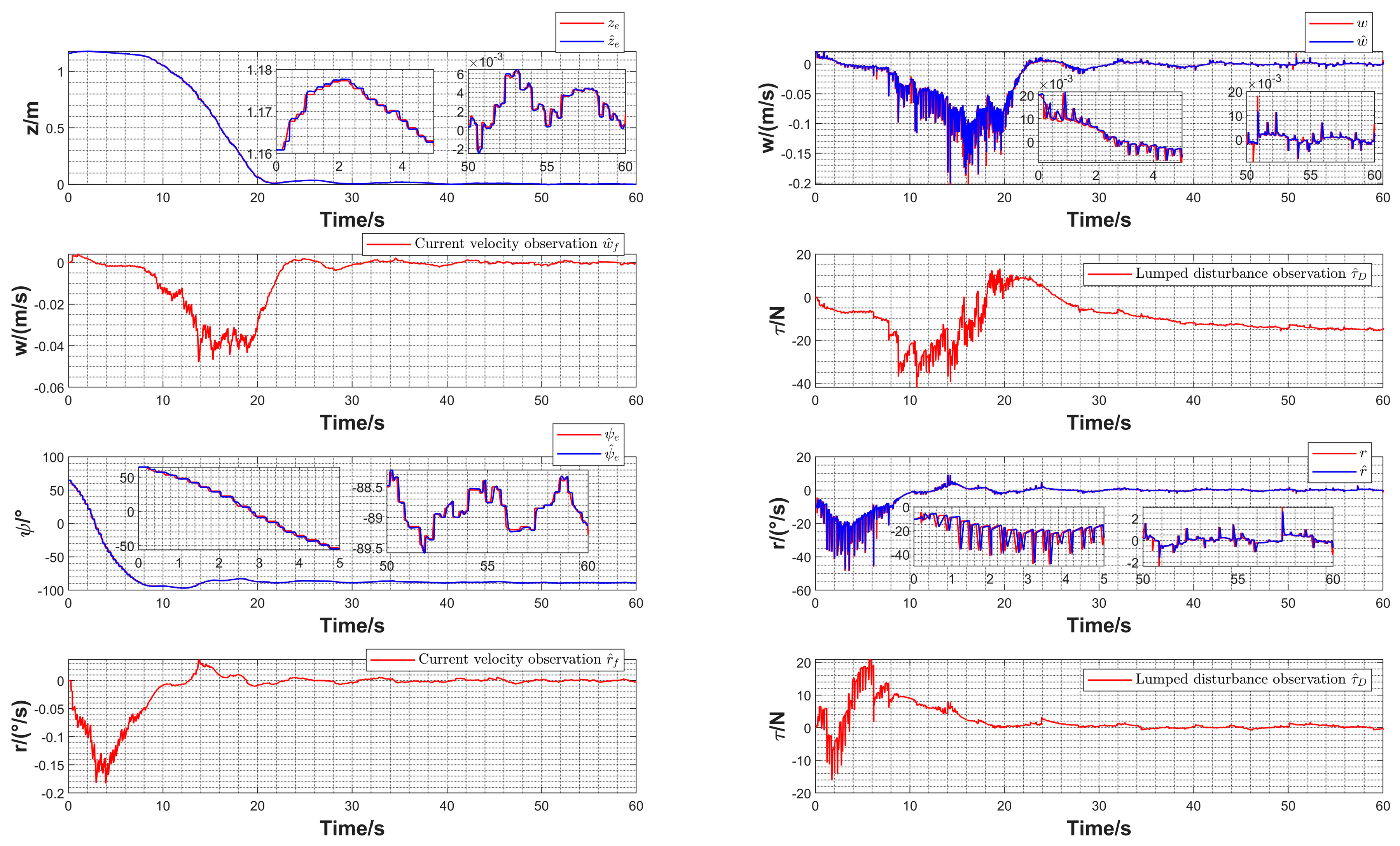
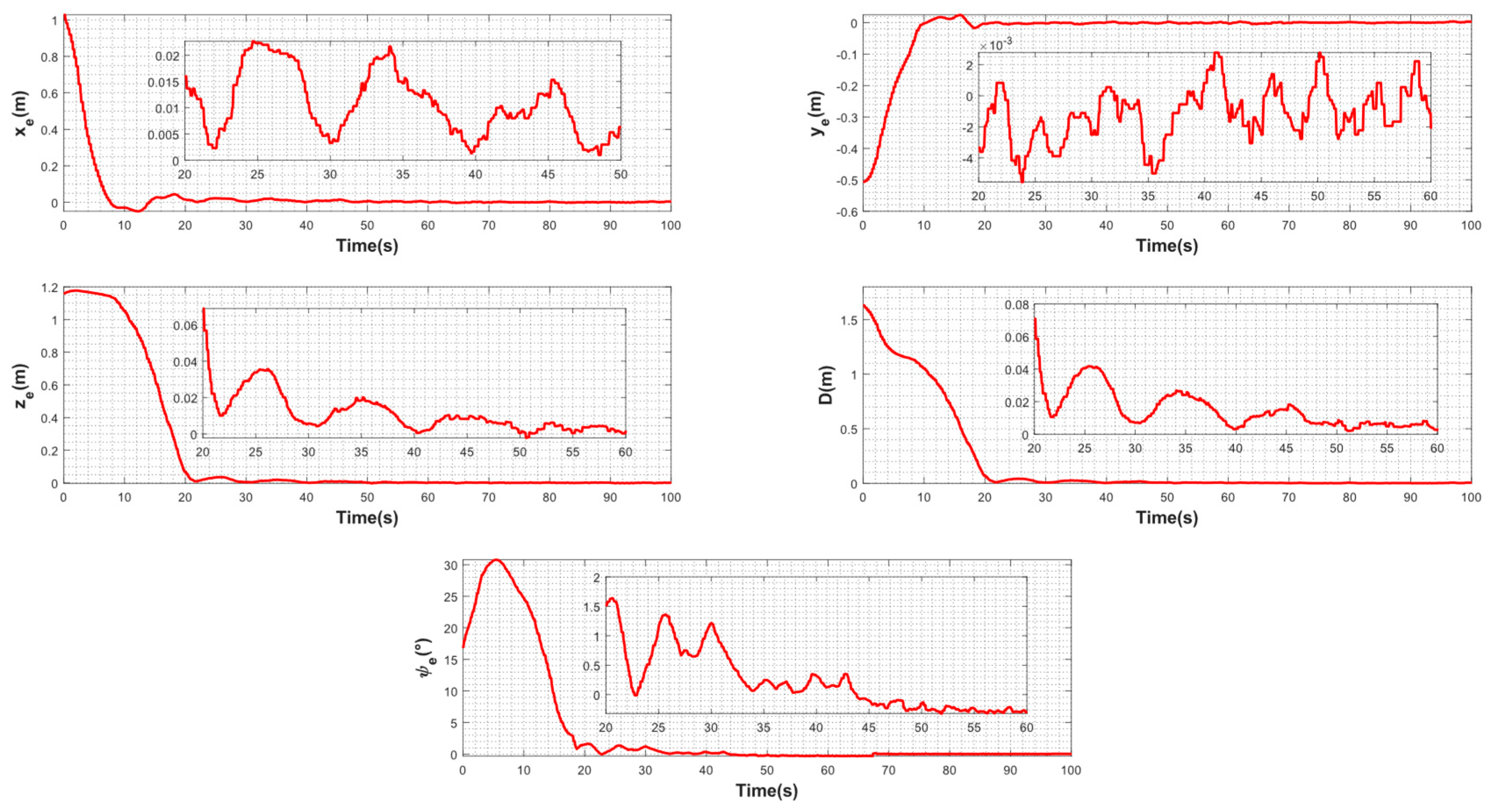
| Performance Indicator | Control Scheme | ||||||
|---|---|---|---|---|---|---|---|
| Position root-mean-square error (m) | MFSESO-DFOPID | 0.7606 | 0.0762 | 0.0833 | 0.0017 | 0.0010 | 3.36 × 10−5 |
| MFSESO-DPID | 0.7716 | 0.0789 | 0.1280 | 0.0028 | 0.0016 | 2.57 × 10−4 | |
| Position adjustment time (s) | MFSESO-DFOPID | 9.874 | 3.472 | 3.628 | 2.996 | 2.596 | 0.162 |
| MFSESO-DPID | 10.030 | 2.836 | 5.610 | 3.118 | 3.310 | 0.668 | |
| Position steady-state error (m) | MFSESO-DFOPID | −0.0100 | 0.0019 | 1.34 × 10−5 | −2.86 × 10−7 | 2.18 × 10−7 | −0.0003 |
| MFSESO-DPID | −0.0347 | 0.0090 | 6.78 × 10−7 | −2.41 × 10−6 | 2.07 × 10−6 | −0.0032 | |
| Velocity root-mean-square error (m/s) | MFSESO-DFOPID | 0.0167 | 0.0167 | 0.0179 | 0.0050 | 0.0033 | 2.86 × 10−4 |
| MFSESO-DPID | 0.0371 | 0.0308 | 0.0538 | 0.0067 | 0.0042 | 4.78 × 10−4 | |
| Velocity adjustment time (s) | MFSESO-DFOPID | 0.224 | 0.698 | 1.486 | 0.250 | 0.258 | 0.252 |
| MFSESO-DPID | 12.542 | 2.916 | 9.256 | 0.330 | 0.422 | 0.318 | |
| Velocity steady-state error (m/s) | MFSESO-DFOPID | −0.0100 | 0.0022 | 1.32 × 10−5 | −2.86 × 10−7 | 1.98 × 10−7 | −0.0005 |
| MFSESO-DPID | −0.0335 | 0.0105 | 1.66 × 10−7 | −2.39 × 10−6 | 1.89 × 10−6 | −0.0045 |
| Performance Indicator | Control Scheme | ||||||
|---|---|---|---|---|---|---|---|
| Root-mean-square error of ocean current velocity observation (m/s) | MFSESO-DFOPID | 0.0080 | 0.0080 | 0 | 0 | 0 | 0 |
| LESO-DFOPID | 0.0091 | 0.0091 | 0 | 0 | 0 | 0 | |
| Adjustment time of ocean current velocity observation (s) | MFSESO-DFOPID | 0.524 | 0.532 | 0 | 0 | 0 | 0 |
| LESO-DFOPID | 1.078 | 1.082 | 0 | 0 | 0 | 0 | |
| Steady-state error of ocean current velocity observation (m/s) | MFSESO-DFOPID | −4.73 × 10−4 | −5.83 × 10−5 | 0 | 0 | 0 | 0 |
| LESO-DFOPID | −5.86 × 10−4 | −8.95 × 10−4 | 0 | 0 | 0 | 0 | |
| Root-mean-square error of lumped disturbance observation (N) | MFSESO-DFOPID | 2.039 | 1.738 | 2.193 | 1.213 | 1.624 | 0.597 |
| LESO-DFOPID | 2.953 | 2.119 | 3.320 | 2.517 | 3.720 | 1.031 | |
| Adjustment time of lumped disturbance observation (s) | MFSESO-DFOPID | 10.002 | 1.888 | 3.334 | 0.912 | 0.942 | 0.738 |
| LESO-DFOPID | 10.500 | 3.218 | 3.604 | 2.660 | 2.754 | 2.036 | |
| Steady-state error of lumped disturbance observation (N) | MFSESO-DFOPID | −0.043 | 0.0022 | 0.0016 | 0.0051 | 0.0034 | 0.0005 |
| LESO-DFOPID | 0.126 | 0.0105 | −0.0207 | 0.0031 | −0.0050 | 0.0088 |
Disclaimer/Publisher’s Note: The statements, opinions and data contained in all publications are solely those of the individual author(s) and contributor(s) and not of MDPI and/or the editor(s). MDPI and/or the editor(s) disclaim responsibility for any injury to people or property resulting from any ideas, methods, instructions or products referred to in the content. |
© 2024 by the authors. Licensee MDPI, Basel, Switzerland. This article is an open access article distributed under the terms and conditions of the Creative Commons Attribution (CC BY) license (https://creativecommons.org/licenses/by/4.0/).
Share and Cite
Liu, W.; Guo, L.; Li, L.; Xu, J.; Yang, G. Fractional Active Disturbance Rejection Positioning and Docking Control of Remotely Operated Vehicles: Analysis and Experimental Validation. Fractal Fract. 2024, 8, 354. https://doi.org/10.3390/fractalfract8060354
Liu W, Guo L, Li L, Xu J, Yang G. Fractional Active Disturbance Rejection Positioning and Docking Control of Remotely Operated Vehicles: Analysis and Experimental Validation. Fractal and Fractional. 2024; 8(6):354. https://doi.org/10.3390/fractalfract8060354
Chicago/Turabian StyleLiu, Weidong, Liwei Guo, Le Li, Jingming Xu, and Guanghao Yang. 2024. "Fractional Active Disturbance Rejection Positioning and Docking Control of Remotely Operated Vehicles: Analysis and Experimental Validation" Fractal and Fractional 8, no. 6: 354. https://doi.org/10.3390/fractalfract8060354







